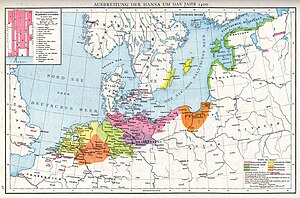Hanseatic League Hanse Hansa | |
|---|---|
 Northern Europe in the 1400s, showing the extent of the Hanseatic League | |
| Informal capital | Lübeck (Free City of) |
| Lingua franca | Middle Low German[1][2] |
| Membership | Various cities across the region of the Baltic and North Seas |
| Today part of | |
The Hanseatic League[a] was a medieval commercial and defensive network of merchant guilds and market towns in Central and Northern Europe. Growing from a few North German towns in the late 12th century, the League expanded between the 13th and 15th centuries and ultimately encompassed nearly 200 settlements across eight modern-day countries, ranging from Estonia in the north and east, to the Netherlands in the west, and extended inland as far as Cologne, the Prussian regions and Kraków, Poland.
The League began as a collection of loosely associated groups of German traders and towns aiming to expand their commercial interests, including protection against robbery. Over time, these arrangements evolved into the League, offering traders toll privileges and protection on affiliated territory and trade routes. Economic interdependence and familial connections among merchant families led to deeper political integration and the reduction of trade barriers. This gradual process involved standardizing trade regulations among Hanseatic Cities.
During its time, the Hanseatic League dominated maritime trade in the North and Baltic Seas. It established a network of trading posts in numerous towns and cities, notably the Kontors in London (known as the Steelyard), Bruges, Bergen, and Novgorod, which became extraterritorial entities that enjoyed considerable legal autonomy. Hanseatic merchants, commonly referred to as Hansards, operated private companies and were known for their access to commodities, and enjoyed privileges and protections abroad. The League's economic power enabled it to impose blockades and even wage war against kingdoms and principalities.
Even at its peak, the Hanseatic League remained a loosely aligned confederation of city-states. It lacked a permanent administrative body, a treasury, and a standing military force. In the 14th century, the Hanseatic League instated an irregular negotiating diet that operated based on deliberation and consensus. By the mid-16th century, these weak connections left the Hanseatic League vulnerable, and it gradually unraveled as members merged into other realms or departed, ultimately disintegrating in 1669.

The League used a variety of vessel types for shipping across the seas and navigating rivers. The most emblematic type was the cog. Expressing diversity in construction, it was depicted on Hanseatic seals and coats of arms. By the end of the Middle Ages, the cog was replaced by types like the hulk, which later gave way to larger carvel ships.
- ^ Gabrielsson, Artur (1983). "Die Verdrängung der mittelniederdeutschen durch die neuhochdeutsche Schriftsprache" [The displacement of the Middle Low German by the New High German written language]. In Cordes, Gerhard; Möhn, Dieter (eds.). Handbuch zur niederdeutschen Sprach – und Literaturwissenschaft [Handbook on Low German Linguistics and Literature Studies] (in German). Berlin: Erich Schmidt Verlag. pp. 119–181. ISBN 978-3-503-01645-7.
- ^ Blank, Angelika (1 June 2008). "Die Hanse - Bündnis mit Tradition" [The Hanseatic League - an alliance with tradition] (in German). wendland-net.de. Retrieved 1 October 2021.
- ^ "Synonym-Details zu 'Deutsche Hanse · Düdesche Hanse · Hansa Teutonica (lat.)". openthesaurus. Retrieved 9 June 2018.
Cite error: There are <ref group=lower-alpha> tags or {{efn}} templates on this page, but the references will not show without a {{reflist|group=lower-alpha}} template or {{notelist}} template (see the help page).